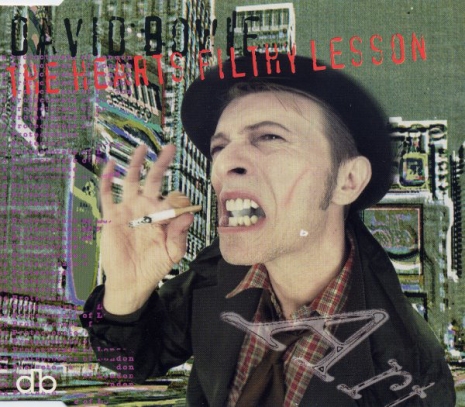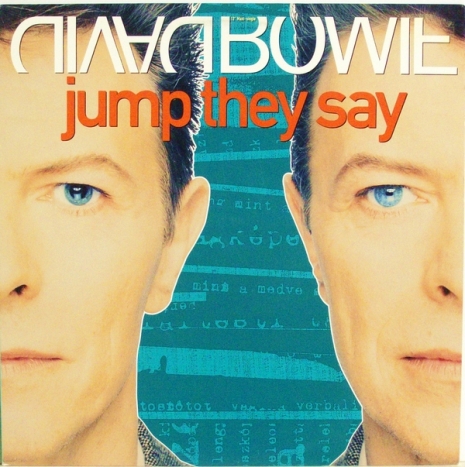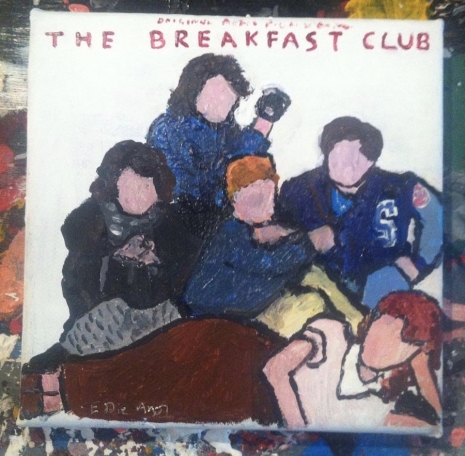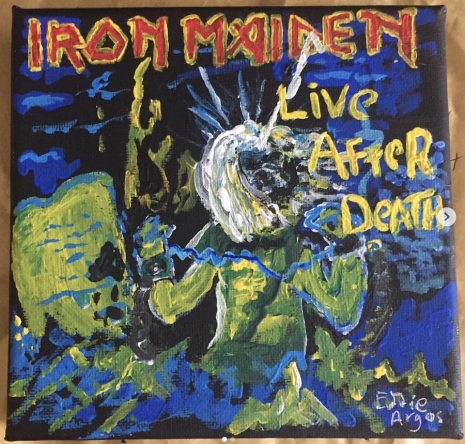
In 1994 the well-known artistic impresario André Heller invited his chums David Bowie and Brian Eno to his native Austria in order to spend a day in the town of Klosterneuburg, on the northern edge of Vienna, to visit the Maria Gugging Psychiatric Clinic (universally known as “Gugging”). The visit to the clinic formed one of the primary inspirations for one of Bowie’s longest and most challenging albums, Outside.
Fortunately for us, Heller also invited his friend, Austrian photographer Christine de Grancy, along. De Grancy took plentiful photos of the encounter but quite astonishingly, she desisted from even developing the negatives until about a year ago, on the occasion of Heller’s 70th birthday. Forty-four splendid photographs of that intriguing day are currently on display in the Crone Galerie in Vienna.
The story of Gugging as an enlightened place of artistic healing has dark roots. During World War II, Gugging was the site of the Nazi-sanctioned murder of hundreds of mentally deficient patients. In the late 1950s, a psychiatrist named Leo Navratil chose Gugging to be the site of his project involving the exposure of the artistic process to mental patients as a form of therapy. Rather than hide the patients or shut them down with medication, Navratil felt that the artistic process might yield beneficial effects on even schizophrenic patients. Over time, he did discover that some of his patients had authentic artistic talent, and Gugging became linked with the artistic movement started by Jean Dubuffet known as Art Brut, which in the U.S. we would be more likely to call “outsider art.”
It is likely an oversimplification to say that David Bowie’s interest in the treatment of schizophrenics derived from the fact that his stepbrother, Terry Burns, suffered from schizophrenia; sadly, Burns committed suicide in early 1985 by permitting himself to be run over by a train at the Coulsdon South train station near London. Many have concluded that Bowie’s early song “The Bewlay Brothers” is a meditation on his half-brother. Eight years after Burns’ death, on Black Tie White Noise, Bowie released “Jump They Say,” which was an even more explicit treatment of the subject: Bowie told the NME that the song was “semi-based on my impression of my stepbrother.” (It’s interesting, isn’t it, that with the term “stepbrother,” Bowie semi-consciously places Burns in the category of “not a blood relation.”) “Jump They Say” was Bowie’s last top 10 single in the UK until 2010, when he scored with “Where Are We Now?”
One of the motives Heller had in inviting Bowie to Gugging was to remind him that the treatment of schizophrenics can employ different methods—and yield different outcomes. It’s beyond plausible that Bowie may have felt an exceptional connection to the goings-on at the Gugging clinic.

The date of the visit was September 8, 1994. I was actually a resident of Vienna at the time. He wasn’t on tour, so there wasn’t a concert for me to attend. Pech gehabt. Bowie and Eno interacted with the patients—and some sort of Jause, the Austrian term for a convivial afternoon snack, was served.
Bowie and Eno spent three hours at Gugging, and de Grancy didn’t even take out her camera until an hour had passed, preferring instead to take the temperature of the moment. De Grancy’s hesitancy in this regard demonstrates something that is quite unusual, which is that these pictures show a Bowie that is about as private as you are likely to find anywhere. Bowie was present not as a rock star but in his role as a working artist and a private individual—an individual who nine years earlier had lost a close relative to schizophrenia. Bowie was consumed with observing the inmates, none of whom, recall, had the slightest notion of who David Bowie was. (We are permitted the fleeting thought that Bowie found this odd anonymity refreshing.)
The 1994 visit was not the first time that Bowie and Eno had been to the clinic. In 1995, the Independent on Sunday ran an interview with the two musicians conducted by Tim de Lisle, in which the two men discussed a visit to Gugging that had taken place while they were cavorting about in Berlin in the late 1970s:
“Didn’t we go originally way back in the late Seventies?” Bowie says. “To see l’art brut while we were mixing albums?”
“Yes, well, we probably did,” says Eno.
Needing an ashtray, Bowie slips the cellophane off one of the waiting packets and taps his ash into it. Eno, silently, finds the ashtray.
I ask what the outsider pictures were like. Bowie sighs, as if the question is unanswerable.
-snip-
“What I derived from Gugging the first time,” Bowie goes on, “was the sense that none of them knew they were artists. It’s compelling and sometimes quite frightening to see this honesty. There’s no awareness of embarrassment.”
Eno, who has been murmuring assent, says: “It’s very interesting to see people who are not taking part in any of the ideological arguments. Who are neither for nor against Cubism, or anything. It’s like you could suddenly meet people who didn’t care whether there was a God.”
At any rate, a year after that lovely afternoon in Klosterneuburg, Bowie released Outside, which is technically titled 1. Outside. The album represented Bowie’s reunion with Eno, who had been so instrumental in the creation of Bowie’s Berlin masterpieces. The album takes the form of a fractured narrative, which the unwieldy subtitle of the album refers to as “The Diary of Nathan Adler or the Art-Ritual Murder of Baby Grace Blue—A Non-Linear Gothic Drama Hyper-Cycle.” (Exhale.) The album deals with “art crimes” and “concept muggings” investigated by the “Arts Protectorate of London,” and features characters named Leon Blank, Algeria Touchshriek, and the notorious art terrorist Ramona A. Stone.
At the press conference to introduce the album (see below), Bowie credited his visit to Gugging as forming “one of the atmospheres for the album.” Here’s the full quote:
Gugging was an incredible experience. ... A mututal friend of Brian Eno’s and myself, André Heller, who’s an artist and something of an entrepreneur, suggested we might like to do some work there or with the inmates or—somehow, he wanted us to go and see Gugging and see what’s going on. And what it is, it’s a hospital where 100 percent of the inmates are involved in the visual arts. ... So many inmates in hospitals in and around Austria showed a proclivity for the visual arts that they thought it might be a good idea to give them their own wing where they could sort of examine and create things, and this is the, this is really the foudnation of what’s subsequently become called ‘outsider art.’ And we went and talked to the patients there and looked at what they were doing. It reminded me a lot, of course, of a museum in Switzerland called L’art Brut, which is in Lausanne, that was started by Dubuffet, a similar source of ideas, I think. And I just like the sense of exploration and the lack of self-judgment about what the artists were doing, and it became one of the atmospheres for the album. I enjoyed it very much.
Much more after the jump…
Posted by Martin Schneider
|
01.19.2018
09:41 am
|











